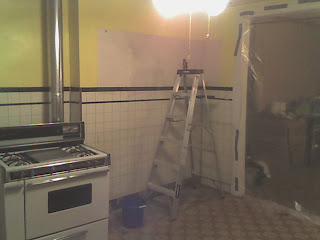
I had done some of the electrical prior to prepping for drywall for practicality's sake (I needed light to work in the kitchen), but I'll recount how I went about it here since it makes more sense for chronology's sake.
The last thing to do before buttoning up the walls is electrical and plumbing--experience in which I possessed none. Fortunately, I was able to easily tap the copper water lines and sewer stack that were running up to the upstairs bathroom, which were conveniently located behind the wall I had just demolished, approximately 18" from where I planned on installing the sink.
Not knowing anything about soldering pipe, and basing it only on my experience with soldering electronics, I wasted an entire spool of solder that came with the torch. I bought another spool and researched the correct method on the Internet. I had the torch heat far too low, and I didn't realize that the idea is to heat the pipe to the temperature that will melt the solder, not vice versa. After that, it was cake.
Tapping the sewer stack was a little more tricky. Ordinarily, PVC (the white plastic pipes) joints are as simple as 1) coating with purple acetone cleaner 2) coating with epoxy 3)inserting pipes into joints and 4) turning 1/4 turn. I had no problem with that until it came to make the last connection. Because I was connecting the top of the stack, (which was fixed) to the bottom of the stack (which was also fixed) I could not turn the joint 1/4 turn. After screwing up twice (looked fine, but leaked), I decided to go with a rubber boot (absent from the above picture) to make the final connection. It's simply a rubber boot that you slip over each end of the joint, with hose clamps that are tightened down. Worked like a charm, and it was cheap too.
Next was electrical. I was planning on installing recessed lights in the kitchen. Recessed lights (cans) come in two varieties - new construction, and remodel. The remodel cans are simply inserted into a hole in a finished ceiling, then you turn screws on the can which extend little arms that hold it in place. New construction cans have adjustable length hanger bars that are simply nailed into the joists. I purchased the remodel cans first, but realized quickly that 1) stud finders to not work on plaster ceilings and 2) the arms on remodel cans are not designed to accommodate the thickness of a plaster ceiling and will not work with a plaster ceiling.
Since I was covering up the plaster ceiling entirely anyway, I decided I would jury-rig the new construction cans to work. To accommodate for the thickness of the ceiling, I first attached 2x4s to the joists, and then attached the cans to the 2x4s, which hung lower than the joists, thus lowering the cans, and accommodating for the thick ceiling.


As you can see from the above picture, cutting the hole for the recessed light in the upper right corner removed all of the support that corner of the ceiling had. It collapsed entirely. I decided to deal with that later.
I also installed pendant lights. For some reason, the remodel electrical boxes seemed to work ok here. You can see here where I hit a stud by mistake and had to install my electrical box a couple inches to the right.

I also wired a GFI outlet for the kitchen backsplash and attached 3 more outlets to that. In most localities, all that is required to meet code for outlets in wet locations is that the first outlet in the series be a GFI. That outlet, so long as its functioning properly, will automatically cut power to any outlets after it on the same line, if there is a ground fault in any of those proceeding outlets.






